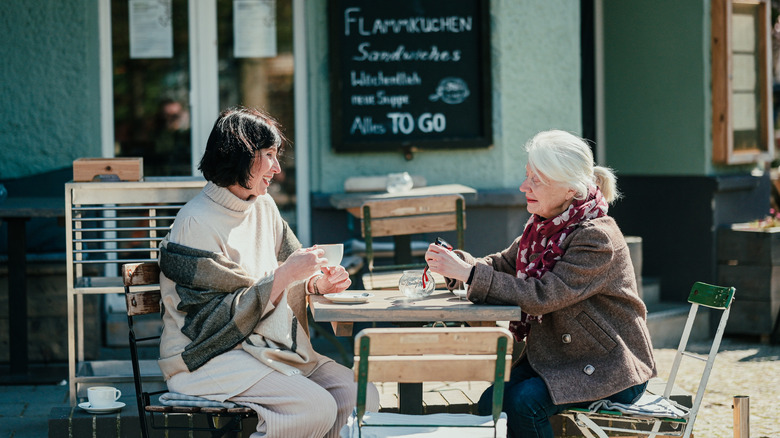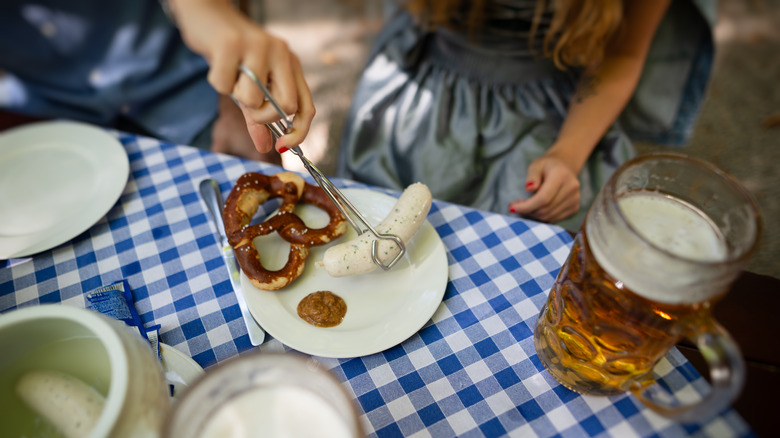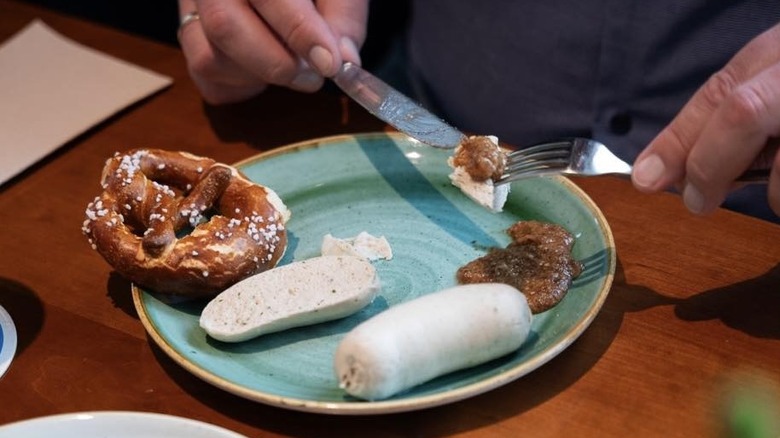The Tasty Food German Locals Will Side-Eye Tourists For Ordering After Noon
They say that breakfast is the most important meal of the day, and one of the joys of a European road trip is checking out all the different delicacies each country or region serves up for morning sustenance. Putting aside the ubiquitous buffet-style continental breakfast provided by many hotels, the variety is eye-catching. It can range from gut-busting fry-ups in Britain, open sandwiches in Sweden, fresh croissants in France, or flaky burek pastries in Serbia and other Balkan nations. Eggs may play a part, such as pincho de tortilla in northern Spain or Czech hemenex (ham and eggs). If you're visiting Germany, breakfast is generally a relaxed affair, but one German staple will get you funny looks from the locals if you order after midday: Munich's famous white sausage called weisswurst.
Sausages are big, both in terms of size and popularity, in Munich and other central European cities. The Germans enjoy a wide variety, from the world-famous bratwurst to chunky links of fleishwurst, salami-like mettwurst, and luncheon meat-style gelbwurst. A range of regional favorites find their way into currywurst, a hugely popular fast food snack. In short, Germany has a sausage for just about every time, mood, and occasion. Which brings us back to weisswurst, a Munich speciality that is very much a morning-only thing if you want to eat like a Bavarian.
Why should white sausage be eaten before noon?
The popular legend states that the invention of Munich white sausage came about in 1857 when a butcher named Sepp Moser was preparing a large Sunday feast. While making his sausages, he ran out of casings made from sheep intestines and substituted thinner pork casings. Fearing that the skins might split on the grill, he boiled the sausages instead. Moser's innovation was a hit with his guests, and the tradition of weisswurst was born.
Made from finely minced veal, pork, and a variety of herbs and seasonings, these links might look a little unappealing to travelers used to eating grilled or fried sausages with a good bit of sear on the outside. As the name suggests, they are ghostly white and usually served bobbing around in a dish of hot water. Germans eat them with a soft pretzel, a dollop of mustard, and a glass of wheat beer.
Since Mr. Moser's happy accident in the 19th century, white sausages have become a breakfast tradition south of the weißwurstäquator (white sausage equator), largely for a very practical reason. Traditionally, they were made without preservatives or refrigeration, and local wisdom states that they should never last long enough to hear the church bells at noon. While this rule has relaxed to include weisswurst in lunchtime menus and even as an afternoon snack, your best option is to eat early if you want to avoid looking like a tourist on your trip to Germany.
How to eat Bavarian white sausage
While sausage connoisseurs will often talk about the "snap" of a sausage's skin, eating weisswurst casing is guaranteed to make you stand out as an amateur. Bavarians have a few specific methods of eating their breakfast sausage, all of which involve removing or avoiding the skin. You can use a knife and fork to slit it length-wise and shed the casing, or snip one end and peel it like a banana before cutting the meat into bite-size pieces. To eat like a real Bavarian, however, you need to get primal and ditch the cutlery for a bit of zuzeln (Bavarian for "sucking"). Simply remove one end of the sausage and suck the meat from its casing.
So you've got the timing (before noon) and the method down, but you're not out of the woods yet. You must also choose the correct condiment to pair with weisswurst, which in this case is Bavarian sweet mustard, a dark and grainy style familiar across southern Germany. Bog-standard yellow hot dog mustard is a no-no.
Lastly, while the morning might seem a little early to start drinking alcohol, it's worth making an exception for the full weisswurst experience. It is normal with a Bavarian breakfast and doesn't mean everyone is tanked up by the afternoon. The best pairing is a weissbier, or wheat beer, which goes down as a treat with sausage and pretzel. A lighter and less alcoholic option is a radler, a mix of beer and lemonade.


